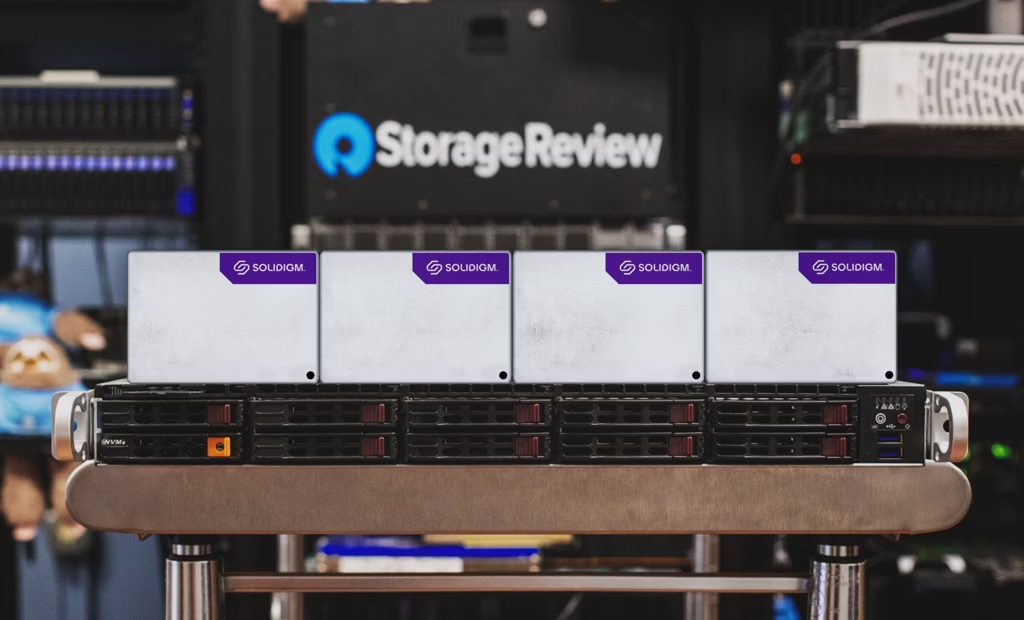Modernize Cloud DVR Infrastructure with High-Capacity Solidigm™ D5 Series SSDs
The cDVR market is expanding rapidly. This growth is driven by consumer demand for more content and convenience from cable and telecom service providers. Faced with an overwhelming array of content choices across hundreds of channels and streaming services, subscribers are increasingly willing to pay for cDVR to control what they watch, when they watch it, and on which devices they use streaming services, both inside and outside of their homes.
With the popularity of cDVR, consumers are demanding near-unlimited capacity. Compared to other technologies, Solidigm D5 Series SSDs are well-suited for cDVR growth and scalability needs.

Data center storage for cloud digital video recorder (cDVR) applications
cDVR is appealing because it allows subscribers to save TV shows, movies, on-air programs, and sports events without the constraints of traditional physical DVRs.
Such set-top DVR boxes have limited capacity, often requiring that viewers delete old shows to make room for new ones. Maintenance and updates for set-top DVR devices are expensive for service providers, with an average of $150 per truck roll in the North America region.1 These devices are also closed systems, inaccessible to lucrative advertising models.
cDVR makes sense for streaming service providers
It’s for these reasons that cDVR is attractive to service providers, who are constantly innovating to add new features that retain current users and draw new ones. Recent examples of these innovative features include:
- Catch-up TV (view after the program has aired)
- Restart TV (record from the start after a show is in progress)
- Pause-live TV (pause and resume live programming)
- Follow-me TV (watch a program on one device then continue on another device)
Challenges for cDVR providers
While cDVR brings new revenue opportunities and helps overcome the limitations of set-top DVRs, it presents fresh challenges to service providers. The increased usage of cDVR creates a high-capacity, high-bandwidth storage workload on edge servers with accompanying demands on space, power, and cooling. Large amounts of data at the edge must be efficiently stored and made available to consumers at required service levels.
SSDs support cDVR growth reliably and affordably
The majority of legacy cDVR storage solutions are all-hard-disk-drive (HDD) arrays organized into drives dedicated for active use (record and play back content) and archive use (store content that has not been accessed for a certain time).
These storage solutions are limited in their ability to scale for future premium viewing features and storage needs as cDVR demand continues to grow. They also hamper operational cost efficiencies with cDVR growth because HDDs require a significant footprint at their edge locations, increasing space, power, cooling, and replacement costs. These factors can lead to a high TCO.
The more practical option for cDVR storage needs is to replace inefficient HDD arrays with efficient, scalable Solidigm D5 Series SSDs.
Making the right choice: SSDs for current and future needs
When addressing their growing storage needs, cDVR providers can stay the course and continue to add HDD arrays to their sites or, like most, they can make the move to all-NAND arrays. In doing so, they can decide whether to deploy triple-level cell (TLC) solid state drives (SSDs) or Solidigm D5 Series quad-level cell (QLC) SSDs. This section will look at two scenarios, specifically comparing:
- All–Serial ATA (SATA) TLC to all–NVM Express (NVMe) QLC storage architectures
- All-NVMe TLC to all-NVMe QLC storage architectures partnering with a leading cDVR solution provider, Solidigm modeled a prototypical cDVR site.
The site services 200,000 subscribers with a peak recording concurrency of 100 percent, peak playback concurrency of 30 percent, recording bitrate of 16 megabits per second (Mbps), and playback bitrate of 5.5 Mbps.
For this prototypical site
- Subscribers have access to thousands of channels
- 20% of their storage need is archival
- They need two hours per day of active content storage
- That content is retained for 4 days before processing to archival storage
These requirements drive a total cDVR site need for 43.3 TB of capacity and throughput of 3.44 terabits per second (Tbps). Because both capacity and input/output (I/O) needs must be met, storage requirements are determined by the higher number of drives required for capacity or I/O.
Evaluating all-SATA TLC storage vs. all-NVMe QLC NAND SSD storage
For this scenario, Solidigm compared servers utilizing SATA-based 7.68 GB Solidigm D3-S4511 SSDs to servers with NVMe-based 30.72 TB Solidigm D5- P5316 drives that are built on QLC NAND.
The pre-populated server cost of $10,000, server material cost of $50, 1,100-W power requirement, and failure rate of 0.40% were assumed equal for the systems.3
With lower performance than NVMe SSDs, the determining factor for SATA SSD drive count was throughput.
Conversely, with much higher performance than SATA SSDs, the drive count determinant for QLC NAND SSDs was the combined capacity requirements of active and archive drives. Table 1 summarizes the findings.
The overwhelming capital expenditure (capex) and operating expense (opex) savings of NVMe SSDs lead to a total TCO advantage of 36%.2

Table 1. SATA TLC NAND SSD versus NVMe QLC NAND SSD TCO comparison2
Efficient scaling with QLC NAND SSDs
TCO isn’t the only story here. The QLC NAND SSD solution also provides for more efficient scaling. The SATA SSD solution consumes 19 total racks, while QLC NAND SSDs consume only five, saving a massive amount of floor space and allowing for efficient capacity scaling as users and content are added.
Even with far fewer drives, the total I/O capacity of QLC SSDs (9.73 Tbps) also enables efficient I/O scaling to support more users and more features.2
Evaluating all-NVMe TLC storage vs. all-NVMe QLC NAND SSD storage
In this scenario, an all-NVMe TLC NAND SSD approach using 15.36 TB Micron 9300 drives was compared to an all-NVMe QLC NAND SSD approach using 30.72 TB Solidigm D5- P5316 drives.
The pre-populated server cost of $10,000, server material cost of $50, 1,100-W power requirement, and failure rate of 0.40 percent were assumed equal for the systems.5
Higher capacities enabled by D5 Series NAND SSDs deliver significant opex savings. Requiring only five racks to deliver the targeted total capacity, compared to nine racks for the TLC NAND SSDs, QLC NAND SSDs enable reductions in costs for power, cooling, racks, and drive replacement. These reductions lead to a TCO savings of 32 percent, as shown in Table 2.5

Table 2. NVMe TLC NAND versus QLC NAND SSD TCO comparison5
QLC NAND is a better choice for reasons beyond TCO savings
TLC NAND will not keep pace with the drive capacities of QLC 3D NAND, and it therefore is not as well suited to scaling with growing storage needs. Solidigm 3D NAND technology is built to scale beyond four bits per cell, with a roadmap designed to meet the long-term needs of the cDVR market.
In addition, it is worth reiterating that the savings for both comparisons are for only one site. As cDVR service providers look to realize savings at scale through deployment of modern storage, the D5 Series advantage becomes even more clear.

Table 3. Comparison of TCO for TLC NAND SSDs and QLC NAND SSDs as the number of sites scales
Ample endurance for cDVR workloads with QLC NAND SSDs
Solidigm D5 Series SSDs provide class-leading endurance,6 and when combined with their large capacities, they can deliver more than sufficient endurance for cDVR workloads.
The endurance viability of a cDVR drive can be determined by comparing the required total bytes written (TBW, measured as terabytes written) to the available TBW of the storage system. Required writes is a combination of the writes to the active cDVR tier (write demand from peak recording for a private copy model) and writes to the archive tier (mostly off-peak-hour writes for aged content). In one prototypical scenario, this might total 7,272 TB/day, or 2,654,280 TB/year.
Available TBW is determined by multiplying the number of drives in the storage system, the drive writes per day (DWPD) rating for all drives, the drive capacity, and the number of days in five years. In the same prototypical scenario, using solidigm D5-P5316 drives, the equation is as follows:
1,216 drives × 0.41 DWPD × 30.72 TB/drive capacity × 365 days/year × 5 years = 27,951,268 TBW available over five years (highlight this text with quote or some other way)
Dividing “TBW available” (27,951,268) by terabytes required per year (2,654,280) yields 10.5 years. This demonstrates that Solidigm QLC NAND SSDs have the endurance to last more than twice the specified drive life for this prototypical cDVR workload.
Conclusion: Solidigm D5 Series SDDs are ready for your cDVR services
QLC NAND technology is not as new as one might think. Solidigm is shipping its third generation of QLC 3D NAND SSDs, and since the first generation, these SSDs have been delivering the same JEDEC standard quality and reliability as TLC NAND technology. Their quality and reliability far exceed that of HDDs, and they offer more than enough endurance for cDVR workloads.
By delivering both TCO and scalability benefits that exceed that of SATA and NVMe-based TLC NAND SSD– based storage servers, mature QLC NAND technology is the clear choice for cDVR service providers.
[1] Mediakind. “Cloud DVR – what have we learned from the last 6-8 years?” Mediakind.com/blog/cloud-dvr-what-have-we-learned-from-the-last-6-8-years/.
[2] Cost per GB of the Solidigm SSDs is based on Solidigm Recommended Customer Price (RCP) as of September 27, 2021. Actual price can vary and may not reflect the pricing used in the TCO model.
[3] Solidigm SSD actual annualized failure rate (AFR). The Solidigm D3-S4511 is based on internal Solidigm TLC SSD and QLC SSD data. The Solidigm D5-P5316 is projected actual AFR based on internal Solidigm TLC SSD and QLC SSD data.
[4] Based on Intel market research as of May 2021.
[5] The cost per GB of the Micron 9300 SSD was based on Newegg pricing (as of September 27, 2021), while the cost per GB of the Solidigm SSD is based on Solidigm Recommended Customer Price (RCP) as of September 27, 2021. Actual price can vary and may not reflect the pricing used in the TCO model.
[6] Class-leading endurance. Comparing a 7.68 TB Solidigm D5-P4320 (2,803 TBW) to a 7.68 TB Micron 5210 ION SSD (700 TBW) based on micron.com/products/ssd/product-lines/5210. Your costs and results may vary.
Tests document performance of components on a particular test, in specific systems. Differences in hardware, software, or configuration will affect actual performance. Consult other sources of information to evaluate performance as you consider your purchase.
Cost reduction scenarios described are intended as examples of how a given Solidigm-based product, in the specified circumstances and configurations, may affect future costs and provide cost savings. Circumstances will vary. Solidigm does not guarantee any costs or cost reduction. Solidigm does not control or audit the design or
Implementation of third-party benchmark data or Web sites referenced in this document. Solidigm encourages all of its customers to visit the referenced Web sites or others where similar performance benchmark data are reported and confirm whether the referenced benchmark data are accurate and reflect performance of systems available for purchase.
Solidigm technologies may require enabled hardware, software or service activation. No product or component can be absolutely secure. Your costs and results may vary. Performance varies by use, configuration and other factors. Solidigm is committed to respecting human rights and avoiding complicity in human rights abuses. Solidigm products and software are intended only to be used in applications that do not cause or contribute to a violation of an internationally recognized human right. Solidigm does not control or audit third-party data. You should consult other sources to evaluate accuracy.
“Solidigm” is a trademark of SK hynix NAND Product Solutions Corp (d/b/a Solidigm). Other names and brands may be claimed as the property of others.


